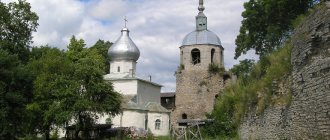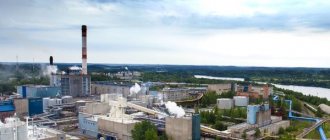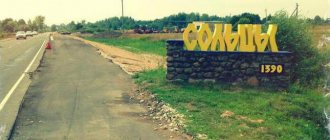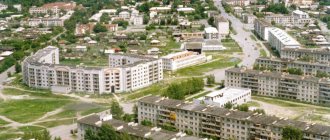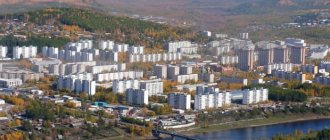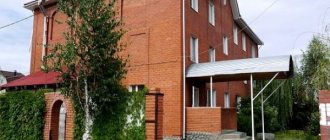For information about other places with the same name, see Borovichi (localty).
City in Novgorod Oblast, Russia
| Borovichi Borovichi | |
| Town[1] | |
| JSC Mstatator Building in Borovichi | |
| Flag Coat of arms | |
| Location of Borovichi | |
| Borovichi Location of Borovichi Show map of Russia Borovichi Borovichi (Novgorod region) Show map of Novgorod region | |
| Coordinates: 58°24′N 33°55'E / 58.400°N Latitude 33.917°E / 58.400; 33.917Coordinates: 58°24′N 33°55'E / 58.400°N. Latitude 33.917°E / 58.400; 33.917 | |
| A country | Russia |
| Federal subject | Novgorod region[2] |
| First mention | 1495 |
| City status from | 1770[3] |
| Height | 90 m (300 ft) |
| population (2010 Census)[4] | |
| • General | 53,690 |
| • Evaluate (2018)[5] | 50,144 (−6.6%) |
| • Classify | 307th in 2010 |
| Administrative status | |
| • Subordinate | city of regional significance Borovichi[2] |
| • Capital from | city of Borovichi of regional significance[2], Borovichi district[2] |
| Municipal status | |
| • Municipal district | Borovichi municipal district[6] |
| • Urban village | Urban settlement Borovichi[6] |
| • Capital from | Borovichi municipal district[6], urban-type settlement Borovichi[6] |
| Timezone | UTC + 3 (MSK [7]) |
| Postal code(s)[8] | 174400, 174401, 174403–174409, 174411, 174421 |
| OKTMO I WOULD | 49606101001 |
| Web site | Borovichi-adm.RU |
Borovichi population
| 2010 Census | 53,690[4] |
| 2002 Census | 57,755[9] |
| 1989 Census | 63,009[10] |
| 1979 Census | 59,646[11] |
Borovichi
(Russian: Borovichi) is the second largest town in Novgorod Oblast, Russia, located on the Msta River in the northern spurs of the Valdai Upland, 194 km (121 mi) east of Veliky Novgorod, then the administrative center of the region. As of the 2010 Census, its population was 53,690.[4]
Geographical location
Located 450 km from Moscow and 175 km from Novgorod, on one of the banks of the Msta River.
This is interesting : the town is depicted in the films “Quiet Whirlpools” and “State Councilor”.
But now there is no theater of its own in the Borovichi mountains of the Novgorod region. What a pity... Wikipedia says: “During the war, the Leningrad Regional Philharmonic, the Leningrad Regional Operetta Theater, in which Galina Vishnevskaya had performed since 1944, and the regional drama and puppet theaters, which performed for the wounded, on the stage of the city theater, in neighboring areas, were evacuated to the city. , went to the front."
The head of the settlement is O.A. Strygin. Borovichi has both its own flag and its own coat of arms, approved several centuries ago.
We are sure that you will be interested in an article about the town of Ozyory near Moscow.
Unemployment rate
The city's unemployment rate is currently around 5%. This is exactly the data published by Novgorodstat. Interestingly, the average age of a working person is now 42 years. It remains approximately the same for men and women. More than half of the workers have secondary vocational education, and only a quarter have higher education.
In recent years, the number of unemployed has been decreasing, but only slightly. Therefore, a lot of people still turn to the employment center in Borovichi. There are about 3,200 people registered who are looking for work. The Borovichi community outreach center notes that at the moment the most effective way to find a job in the city is to turn to relatives, friends and acquaintances for help. This method is used by 86% of the unemployed. On average, it takes people about 10 months to find a job in Borovichi.
Story
The first written mentions date back to 1495. 70 years later they already wrote about it as a commercial and industrial settlement. He left his mark on history thanks to the battle between the Poles and Swedes, which took place at the end of winter in 1612. At that time, the latter became the winners.
City status was granted in 1770, and from that time fairs began to be held several times a year . At the very end of the 18th century, not far from this object, A.V. Suvorov served his exile, after which he went on an Alpine hike.
In the middle of the century before last, a railway was built here. This event became fundamental for the further active development of local industry. In the fall of 1917, Soviet power was established here.
Old photographs depicting the appearance of the city and its surroundings during different periods of its development can be seen in the VK community “Borovichi in old photographs”.
Industrial production
There are many industrial enterprises in Borovichi, which employ the majority of city residents. The Borovichi Refractory Plant produces refractory products and produces frozen semi-finished products, dairy products, sausages, confectionery and bakery products.
There are generally plenty of food production companies in the city. The Borovichi meat processing plant produces semi-finished products and sausages, the local dairy produces dairy products, bakes confectionery and bakery products. The Molochny Dvorik enterprise is engaged in the production of farm dairy products.
Museum of Local Lore
Founded in the house of merchant M.Ya. Shulgin in 1918. It is one of the oldest in the region.
The first exposition was an exhibition dedicated to the life of local nobles and industry of the Novgorod region. Today, within the walls of the local history museum, 5 historical exhibitions are open to the public. More than 2,000 unique exhibits are presented to guests.
It is important to know: the hallmark is the collection of old and Soviet photography, as well as the collection of antique furniture and national costumes.
In addition to the main sightseeing route, there are 5 different excursion routes. The museum hosts themed evenings, lectures and meetings with interesting guests; the cultural program is very diverse. Personal guide services are provided.
Post-war city
After the end of the war, the population of the city of Borovichi continued to grow at a rapid pace, as it was necessary to restore the country's economy and industry. There were plenty of industrial enterprises here, so workers were always needed. By 1959, the population of Borovichi exceeded 44,000 people. In 1967, the number of inhabitants reached 55,000 inhabitants.
In 1982, the population of Borovichi exceeded 60,000 people. Most of the residents lived in the city during perestroika; by 1987 there were 69,000 Borovichi residents. After the collapse of the Soviet Union, the population of Borovichi began to systematically decline every year. Moreover, the decline began in the difficult 90s and continued into the 2000s, when the economic situation in the rest of the country began to gradually improve. Currently, the population of Borovichi, Novgorod region, is 50,896 people.
In terms of the number of residents, the city has dropped to the level of the late 50s of the last century. Now you know how much the population is in Borovichi today.
Museum-estate of A.V. Suvorov
The grand opening of the museum, founded in the commander’s summer house, took place during the Great Patriotic War, in the fall of 1942. At the beginning of the 21st century. outbuildings that had been in ruins since 1925 were restored.
Now the estate is an ensemble of buildings of the 18th century, inside which visitors are presented with several large exhibitions, including those containing original things of A.V. Suvorov. Since the 70s of the last century is considered a branch of the Novgorod United Museum-Reserve.
Address: s. Konchansko-Suvorovskoye, st. Central, 19. Every Tuesday is a day off!
What is worth seeing in Borovichi in one day
Only in Borovichi can you see some valuable structures: the country's first arched bridge and the only surviving estate of Alexander Suvorov. In addition to these two objects, the main attractions of the city include the History Museum.
Arch bridge
- Coordinates on the map: 58.387135, 33.904024.
The first arch bridge in Russia was built according to the design of N.A. Belelyubsky in 1905. At that time, the city flourished due to numerous factories and factories, and therefore could afford such costly construction.
Similar steel bridges soon became popular not only in Russia, but also abroad; one of the structures was erected in Australia in Sydney Harbor.
In 1995, the Borovichi Bridge was given special status. In recent years, the building has become very dilapidated and cannot cope with traffic flow, so since 2006 it is only allowed to move around on foot.
City History Museum
- Address: st. Dzerzhinsky, 7.
The most complete picture of the city, its history and traditions can be obtained in the main museum of Borovichi. The first exhibition dedicated to the native land opened in 1918. The exhibition was placed in the two-story house of merchant M.Ya. Shulgin, the former head of the city. The museum received the name of its founder – S.N. Porshnyakov.
Over the years, the collection of this city landmark was replenished with new antiques; additional rooms had to be allocated for the increased collection. Today, the museum collection consists of more than 2,000 exhibits, and its exhibitions cover the period from ancient times to the present day.
Museum-estate of A.V. Suvorov
- Address: Tsentralnaya st., 19, Konchansko-Suvorovskoye village.
Just three dozen kilometers from Borovichi stands the ancient village of Konchanskoye-Suvorovskoye. In the 18th century, the village was owned by the famous Russian commander Alexander Suvorov. Alexander Vasilyevich and his family owned several estates, but only the estate near Borovichi has survived to this day. In 1797, the elderly general fell out of favor with Emperor Paul I, was exiled to Konchanskoye and spent two years there.
A century and a half later, a museum dedicated to the great commander was opened in the manor house. The opening took place in difficult times - in 1942, in the middle of the Great Patriotic War. In 1965, Suvorov’s summer house was added to the museum complex, which stood on Mount Dubikha not far from the estate.
The building burned down in 1925 and was completely restored 40 years later. Inside the house, the interior of an 18th century noble estate is recreated. Some things and furniture are genuine, some of the items belonged to Alexander Vasilyevich himself. The decor is relatively laconic and modest.
On the territory of the museum you can also see a bronze bust of Suvorov, a brick building of a former church and several wooden buildings: the house church of St. Alexander Nevsky, a barn, a kitchen outbuilding, a bathhouse and a carriage house. The estate has a large park and a small pond that were dug during the lifetime of the famous owner. The commander planted some of the oak trees in the park with his own hands more than 200 years ago.
Estate of landowner Nekhlyudov
The estate was built at the end of the 19th century. in Gothic style. For a long time, its sole owner was the landowner Nekhlyudov, but then a local businessman named Wakhter began to manage the castle.
According to local residents, the legend that the ghost of the former owner’s wife still lives within the walls of the estate is not a legend at all.
At night, especially often when there is a full moon, a roar and strange sounds, similar to a woman’s cry, can be heard from there. During the USSR, a school functioned here. Now the building is in dilapidated condition. What disaster happened here, what happened - local residents will tell visitors.
Entry is prohibited, the windows and doors are boarded up, the castle is located on private property, but there are no guards assigned to it, and tourists often make a planned stop here.
Manor Novoglagodnoe
Located on the river bank since the mid-18th century. It belonged to a relative of the last favorite of Empress Catherine II. During wartime grain was stored here.
In 1999, one of the heirs of the last owner of the estate visited this place and took a direct part in the restoration of the church on the estate.
Monuments
Includes several interesting sculptures on the square. Volodarskogo, st. Sofia Perovskaya and in the park of the 30th anniversary of October:
- Monument to A.V. Suvorov
Made of bronze alloy. Its height is more than 4 meters;
- Giant chair
Installed with money from the Borovichi-Furniture factory. The height of the chair exceeds 8 meters. A wooden chair is a visiting card of the city;
- Monument to S. M. Kirov
The three-meter monument to the Russian revolutionary was erected during the Soviet Union, in 1926.
It was moved to its current location after renovation in 2013. Made of reinforced concrete. The author was the sculptor Z.M. Vilensky;
- Memorial "Eternal Flame"
Located in Victory Park. The complex is dedicated to the memory of the heroes who fought for the freedom and independence of the Soviet people. Ceremoniously opened in 1975. Creator - A.I. Popov.
Production capacity
produces and develops electromagnetic components for electronic equipment; the specialized Borovichi plant produces sand-lime bricks; the building materials plant produces paving slabs, red bricks, and building materials.
An experimental specialized plant and the St. Petersburg branch of OJSC "Red October" were opened in the city - received this status. They produce tools for repairing and joining conveyor belts, as well as vulcanizing presses. At its own production facilities there is a woodworking machine plant that produces four-sided machines.
The company is engaged in the production of steel doors and locks, Borovichi Furniture has established supplies to the market of upholstered and cabinet furniture, and the Elegia enterprise has supplied household furniture. produces educational and soft toys.
Railway station
The complex of buildings belonging to the railway station has retained its appearance in 1876, when it was founded. Until now, the wooden station building, locomotive depot and luggage compartment are used for their intended purpose.
And the water tower located nearby is considered one of the symbols of Borovichi.
Natural objects
The most famous include:
Arboretum
The creator of the unique arboretum, located 35 km from Borovichi, in the village of Opechensky Posad, was S.A. Ushanov. Its creation (the author personally planted all the trees on the territory, built a fountain and several sculptures) lasted about 50 years.
The main attraction inside the arboretum is the figure of Mishka, who speaks in the voice of Semyon Andreevich. There is a picturesque pond and a cozy observation deck. This place is the pride of the entire region.
This is interesting: several species of exotic plants grow here, including Balkan pine, North American walnut and Korean forsythia. The total number of tree species is approaching 180.
Underground river Poneretka
The river is a natural monument. Its second name is Occasionally. It is a left tributary of the Msta. The height of the source is 165 m above sea level, the height of the mouth is 125 m.
Please note: a popular place among tourists not only due to the uniqueness of its location and underground current, but also its suitability for extreme sports - kayaking.
Natural fountain in the village of Megletsy
A unique place. It is a three-meter fountain that flows from underground around the clock.
Lined with large boulders to attract more attention.
Temples and monasteries
These include:
Holy Spirit Monastery
Located in the north of the city. Construction was completed in 1570. In the middle of the 17th century. here rested the relics of St. Jacob Borovichsky. In the pre-war period, the monastery was closed and partially looted.
Reconstruction began at the end of the 20th century, restoration work continues to this day.
Holy spring of Yakov Borovitsky
Named after the miracle worker who was killed by lightning in the 15th century. It is a small chapel located on the street. Sofia Perovskaya in house 63. Anyone can draw holy water from a well, which began at a depth of about 30 meters.
Church of the Nativity of John the Baptist
A newly built church in the Sosnovka microdistrict on Mekhanizatorov Street. The idea of construction belongs to the general director Vitaly Konstantinovich Zykov. He also authored several sketches of the future iconostasis. At the beginning of the 21st century, in the warehouse of his company, workers found a box in which the icon lay, this was the main impetus for the creation of the church.
The completion of construction work dates back to the spring of 2004. In 2006, the Church of the Nativity of John the Baptist was consecrated, and immediately after this event, divine services began to be held here.
This is interesting: the weight of the bell is 525 kg.
Church of the Icon of the Mother of God “Tenderness”
The cross-domed chapel was built in 1871. On this site in the middle of the 15th century. There were burials of the relics of the Borovichi wonderworker - St. James. During the war years, a shoemaker's workshop operated here. In 1993, the building was reconstructed and 2 years later it was reopened to parishioners. New icons are added annually.
Take note: in the basement of the church on Volodarsky Street at 25 there is a source of holy water. There is repeated evidence that water from the source helps get rid of many different ailments.
Paraskeva Pyatnitsa Church
Once upon a time this was the main part of the Borovichi Pyatnitsky churchyard. The temple appeared here in 1796 and was consecrated in the name of Saint Paraskeva Friday. A miraculous spring was located nearby. In the 30s XX century closed, almost completely looted, the chapel was destroyed, the holy spring was filled with lime, and the iconostasis was destroyed with a blowtorch.
For several years there was a weaving artel here. In 1960, the church building began to be restored, and a well was built. Since 1985 it has been the city's main cathedral.
Good to know: today, within the walls of the church, wedding ceremonies are held for married couples, the sacrament of baptism is performed, and sometimes divine services are held. Address: st. Suvorova, 26 "B".
Holy Trinity Cathedral
The full name is the Cathedral of the Holy Life-Giving Trinity. Belongs to the Borovichi diocese. It originates in the 19th century. It was severely damaged during the war years, from the late 90s. the revival began. Today it is open to parishioners, with weekly services held. Address: square named after. Kirova, 9.
Church of the Tikhvin Icon of the Mother of God in Egla
Built in 1874. It is known that five centuries ago there was a wooden church here, which was visited by the Great Emperor Peter I and Catherine II.
Unfortunately, as often happens with wooden buildings, the temple burned down in a fire. The newly built building existed until the 1930s, then it was closed. During the years of inactivity, the temple fell into partial desolation. Only in 1990 did its restoration and restoration begin. The Tikhvin Church was painted by students of the art department of the local art school.
The city's attractions
Perhaps the main attraction of Borovichi is the Holy Spirit Monastery. Initially, it was founded on the Msta River, in the north of the settlement, when it was still a village.
It is not known when it was built; the first mention in ancient Russian documents occurs in 1572. Then all the buildings were still wooden. The formation of the monastery ensemble was completed already in the 19th century.
Under Soviet rule, the monastery was closed, and the heads of the churches were dismantled. Only in 1998 it was transferred to the local diocesan administration. Currently, painstaking work is underway to restore the monastery. It is not yet known when they will be completed.
The visiting card of the city is the arched bridge over the Msta River, which was built back in 1905. The bridge's design resembles a stretched bow. Despite the fact that this structure is quite heavy and very powerful, it looks light and airy thanks to its openwork design.
Hotels
A traveler can stay at one of the hotels: “Olympus”, “Dispensary”, “Metallurg”, “Msta”. All of them are centrally located and within walking distance of the main attractions.
Local residents rent out apartments and rooms to visitors. The average cost of a one-room apartment per day is from 800 rubles to 1,500 rubles.
Recreation and entertainment
According to numerous reviews from tourists, you can eat deliciously and inexpensively in the cafes and restaurants “Summer Garden”, “Day and Night”, “Rainbow”, “Astoria”.
For film lovers, the Europe cinema is open from 10:00 to 23:00.
Shopping and entertainment malls Madagascar and the Olympus water park welcome guests every day.
Attention: everyone can book a group sightseeing bus tour with a guide. Its route allows you to see all the main natural, historical and architectural monuments of Borovichi. This is the best way to get acquainted with the culture and history of the development of an important part of the Novgorod region. Cost - from 1200 rubles per person.
An experienced guide will tell you about each historical site separately, then answer questions from the tourist group. Various discounts and benefits apply.
Tourism in Russian cities is gradually gaining momentum; more and more guests from Moscow, Leningrad, Nizhny Novgorod and other regions come to various large and small cities every year. This area in the Novgorod region is no exception.
Watch the following video for interesting information about the city of Borovichi:
Recommendations
Notes
- Resolution #121
- ^ a b c d f f
Law No. 559-OZ - ^ a b
Borovichi (in Russian). Geographical encyclopedia. Retrieved May 23, 2012. - ^ a b c
Federal State Statistics Service of Russia (2011).
“All-Russian Population Census 2010. Volume 1" [All-Russian Population Census 2010, vol. 1]. All-Russian Population Census 2010 [All-Russian Population Census 2010]
(in Russian). Federal State Statistics Service. - "26. The size of the permanent population of the Russian Federation by municipalities as of January 1, 2022.” Federal State Statistics Service. Retrieved January 23, 2022.
- ^ a b c d f
Law No. 369-OZ - "On the calculation of time." Official Internet portal of legal information
(in Russian). June 3, 2011. Retrieved January 19, 2022. - Post office. Information and computing center of OASU RPO. ( Post office
).
Search for postal facilities ( Search for postal facilities
) (in Russian) - Federal State Statistics Service of Russia (May 21, 2004). “The population of Russia, the constituent entities of the Russian Federation as part of federal districts, urban settlements, urban settlements, settlements, settlements is 3 thousand or more people” [Population of Russia, its federal districts, constituent entities of the federation, districts, urban settlements, rural settlements - administrative centers, rural settlements with a population of more than 3000 people] (XLS). All-Russian Population Census of 2002 [All-Russian Population Census of 2002]
(in Russian). - “All-Union Population Census of 1989. The current population of union and autonomous republics, autonomous regions and districts, territories, regions, urban settlements and villages. All-Union Population Census of 1979. National composition of the population by regions of Russia” [All-Union Population Census of 1979. Ethnic composition of the population by regions of Russia] (XLS). All-Union Population Census of 1979 [All-Union Population Census of 1979]
(in Russian).
1979 - via Demoscope weekly
(website of the Institute of Demography of the State University - Higher School of Economics. - "History of the city and urban management." Russian. Administration of Borovichi municipal district. Archived from the original on November 5, 2012. Retrieved May 23, 2012. Check date values in: | date = (help)
- Snytko, O. V.; and others. (2009). S. D. Trifonov; T. B. Chuikova; L. V. Fedina; A. E. Dubonosova (ed.). Administrative-territorial division of the Novgorod province and region 1727-1995. Directory (PDF) (in Russian). Saint Petersburg. paragraph 96. Received May 22, 2011.
- Monuments of history and culture of the peoples of the Russian Federation (in Russian). Ministry of Culture of Russia. Retrieved June 2, 2016.
- Borovichi Museum of Local Lore (in Russian). Russian Network of Cultural Heritage. Archived from the original on December 30, 2011. Retrieved May 23, 2012.
- "Hockey club" Borovichi." Russian. Hockey club "Borovichi". Archived from the original on February 13, 2012. Retrieved January 23, 2012. Check date values in: | date = (help)
- Save HC "Borovichi". Maybe? (in Russian). bandynet.ru. Archived from the original on March 9, 2012. Retrieved May 23, 2012.
- Stadium "Metallurg", Borovichi (in Russian). Russian Bandy Federation. Retrieved December 1, 2012.
Photo gallery
[Show slideshow]
